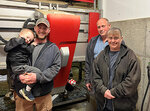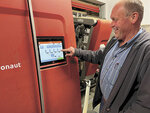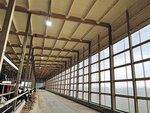ORANGE CITY, Iowa – The Schelling family recently found themselves facing a dilemma.
“Our dairy facilities were getting tired,” Marv Schelling said. “We wanted to expand and build something new, but we didn’t want to become dependent on hired labor. It’s hard to find and keep good hired help.”
Marv and his wife, Kathy, have three grown sons – Keith, Josh and Alex. Keith and his wife, Krystle, have three children – Marlena, Hana and Michael.
Gilbert and Wilma Schelling, Marv’s parents, purchased the Schelling farm in the 1950s. Gilbert and Wilma passed away in 2019.
Typical for the time period, Gilbert and Wilma had chickens, hogs and a dozen dairy cows they milked by hand.
“My parents built a milking parlor that held two cows per side,” Marv said. “In 1975, they purchased a used Surge double-4 parlor and expanded from 40 cows to 80 cows.”
Marv and Kathy built a double-9 parallel parlor and freestall barn in 1991 and expanded to 120 head.
“We added a transition barn in 2002 and began to milk between 160 and 180 head,” Keith said. “Our freestall barn was aging and was becoming overcrowded. About seven or eight years ago, we began to talk about building a new facility that would include robotics.”
Marv said updating the old facilities was not an option.
“The poles needed attention, and the free stalls were the wrong size for modern Holsteins,” he said.
The Schelling family set themselves to the task of learning about milking cows with robots. They visited robotic dairy operations in Iowa, Minnesota, South Dakota and Nebraska.
After consideration, the Schelling family decided to build a barn that is 140 feet wide by 440 feet long. The new barn can hold up to 300 head and features four Lely A5 robotic milkers. The barn has been designed so it can easily be doubled in size. Plumbing and electrical infrastructure has been preinstalled to facilitate this prospect.
“There were so many different choices to make,” Keith said. “We didn’t know what we wanted to do regarding the layout, the bedding and how to handle the manure.”
Space for dry cows was included in the new barn.
“We feel that the dry cows deserve as much consideration as the lactating animals,” Marv said.
Construction commenced in September 2020. The Schellings milked their first cows in their new barn March 29, 2021. The Schelling family, with help from friends and cousins, installed all of the gates, mattresses, free stalls and electric conduits in the barn. They also installed the ductwork that brings fresh air into the rooms that house the milking robots.
“We knew that we would have to build on the hill south of our farmstead to get off the floodplain,” Marv said. “We looked at bedding with sand, but we didn’t have room for a sand lane and an additional lagoon. We also felt that sand wasn’t worth the extra maintenance. That’s why we decided to go with DCC waterbeds and Lely Collectors.”
The five manure collectors in the Schellings’ new barn constantly patrol the alleys. Each one uses a squeegee and vacuum to pick up manure and store it in an onboard tank. The robotic manure machines go to the west end of the barn where they drop their cargo into a shallow trench. Gravity and discarded wash water moves the manure into a small pit. A lift pump then pipes the manure to a nearby lagoon for long-term storage.
The question of how to bed the stalls was a major choice for the Schellings.
“Cow comfort is a top concern for us,” Keith said. “We felt that waterbeds were the best way to keep the cows comfortable. We put chopped straw on the waterbeds three times per week. The cows really like their beds.”
Cow comfort is furthered by a series of stir fans situated throughout the facility. The barn is tunnel ventilated, with a wall of exhaust fans on the east end of the building and an inlet curtain on the west end. The temperature in the barn is automatically adjusted by varying the speed of the exhaust fans and by opening or closing the inlet curtain.
“The cows barely noticed when it got hot last summer,” Marv said.
The barn also features LED lights that simulate the longest day of the year. The sidewalls of the barn are made of translucent polycarbonate, which helps reduce lighting costs.
After more than a year in their new barn, the Schelling family has been able to see how their facility performs under a variety of conditions.
“We have gained 12 to 15 pounds of daily milk production per cow,” Marv said. “Our herd is averaging three milkings per day. Our fresh cows are choosing to be milked up to five times a day and are giving as much as 160 pounds of milk per day. One cow peaked at 168 pounds a day.”
The Schellings’ cows have an average somatic cell count of 220,000. Their herd, which is 38% first-calf heifers, has had an average daily production that has reached as high as 92 pounds per head per day. Over the past several years, the Schellings had used sexed semen to produce the heifers they would need to fill their new barn.
“Our oldest cow is on her 10th lactation, and she is doing well,” Kathy said. “It took her a few weeks to get accustomed to the robots, but she eventually caught on.”
Each cow wears an electronic transponder that identifies her as she enters the milking robot. The transponder also collects a wealth of other information, including the cow’s activity.
“We don’t watch for heats anymore. We breed based on activity,” Marv said. “The robots provide us with a huge amount of information. All of that data can be hard to digest. But, the boys catch onto it quickly and help me figure it out.”
Kathy said the robots check the milk for color and conductivity.
“I think that the robots can catch a case of mastitis before we can,” she said.
Labor savings have proven to be a big plus for the Schelling family.
“It takes two people about three hours per day to manage the robot barn,” Marv said. “That includes fetching cows, breeding and treating.”
Keith enjoys the flexibility of their schedule since transitioning to robots.
“If you’re in the middle of chopping silage and you want to keep going, you can. And, if you want to attend a wedding, you can take off,” Keith said. “The cows won’t care.”
Each member of the Schelling family does different farm chores on a rotating basis.
“Everyone knows how to do everything on the farm,” Marv said. “That makes it a lot easier if you want to get away for a while.”
After being in their new barn for over a year, the Schelling family would change only a few minor details.
“I just wish that Dad had lived long enough to see our new dairy barn,” Marv said. “I think he would have been amazed.”



Comments
No comments on this item Please log in to comment by clicking here